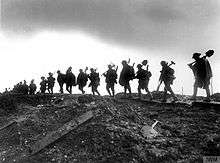32nd Division (United Kingdom)
| 32nd Division | |
|---|---|
 | |
| Active | 1915–1919 |
| Country |
|
| Branch |
|
| Type | Infantry |
| Size | Division |
| Engagements | |
| Commanders | |
| Notable commanders | Reginald Barnes |
The 32nd Division was an infantry division of the British Army that was raised in 1914, during World War I. The division was raised from volunteers for Lord Kitchener's New Armies, that was originally made up of infantry battalions raised by public subscription or private patronage. The division was taken over by the War Office in September 1915. It served in France and Belgium in the trenches of the Western Front for the duration of the war.
The division's insignia was four 'eights' arranged in an 'X' shape.
Unit history
On 10 December the War Office authorised the formation of the Fifth New Army. Like the other Kitchener Armies, it comprised six Divisions, in this case numbered 37 to 42. What eventually became 32nd Division was originally numbered 39th. In April 1915, the original Fourth New Army was broken up and its units converted for training and draft-finding purposes. When this took place the Fifth New Army became Fourth New Army and its Divisions were renumbered to 30th – 35th: thus what we remember as 32nd Division was born.
The Division was composed largely of locally raised units often known as “Pals”. It was a predominantly Northern Division, although locally raised units from Birmingham and Bristol were also in the structure.
After in most cases commencing training near home (although the Glasgow battalions moved to camp at Gailes and the 11th Border at Blackhall), the units were moved in May 1915 to concentrate in Shropshire but Prees Heath was found to be too wet for training and the brigades instead moved to Yorkshire (Wensley and Richmond, with use of the firing ranges at Strenshall). It was not until August that the Division moved for final training and firing practice at Codford on Salisbury Plain.
In November 1915 the Division received a warning order to prepare to sail for France. It remained on the Western Front for the remainder of the war and took part in the following engagements:
1916 The Battle of Albert* The Battle of Bazentin* The Battle of the Ancre*
- the battles marked * are phases of the Battles of the Somme 1916
1917 Operations on the Ancre The pursuit of the German retreat to the Hindenburg Line
1918 The First Battle of Arras, a phase of the First Battles of the Somme 1918 The Battle of Amiens The Battle of Albert^ The Battle of Bapaume^ ^ the battles marked ^ are phases of the Second Battles of the Somme 1918 The Battle of the St Quentin Canal+ The Battle of Beaurevoir+ + the battles marked + are phases of the Battles of the Hindenburg Line The Battle of the Sambre, including the passge of the Oise-Sambre Canal, a phase of the Final Advance in Picardy
32nd Division achieved its best attacking results under Lambert’s command, spearheading Fourth Army’s attacks alongside the Australians between August and October 1918. It was Lambert who informed Field-Marshal Haig of mounting German resistance at Amiens, intelligence that persuaded Haig to refuse Foch’s order to continue the offensive and to switch the axis of advance to Byng’s Third Army on the Scarpe.

Formation
The brigade moved to the 5th Division in December 1915, swapping with the 14th Brigade.
- 14th (Service) Battalion, Royal Warwickshire Regiment, (1st City of Birmingham Battalion)
- 15th (Service) Battalion, Royal Warwickshire Regiment, (2nd City of Birmingham Battalion)
- 16th (Service) Battalion, Royal Warwickshire Regiment, (3rd City of Birmingham Battalion)
- 12th (Service) Battalion (Bristol), Gloucestershire Regiment
- 16th (Service) Battalion, (Newcastle), Northumberland Fusiliers
- 15th (Service) Battalion (1st Salford), Lancashire Fusiliers
- 16th (Service) Battalion (2nd Salford), Lancashire Fusiliers
- 19th (Service) Battalion (3rd Salford), Lancashire Fusiliers (to 14 Brigade January 1916)
- 2nd Battalion, Royal Inniskilling Fusiliers (from December 1915 until February 1918)
- 2nd Battalion, Manchester Regiment (from 14 Brigade February 1918)
- 11th (Service) Battalion (Lonsdale), Border Regiment (until May 1918)
- 1/5th (Cumberland) Battalion, Border Regiment (from May 1918)
- 15th (Service) Battalion (1st Glasgow), Highland Light Infantry (to 14 Brigade January 1916)
- 16th (Service) Battalion (2nd Glasgow), Highland Light Infantry (to Pioneers February 1918)
- 17th (Service) Battalion (3rd Glasgow), Highland Light Infantry (disbanded February 1918)
- 2nd Battalion, King's Own Yorkshire Light Infantry (from December 1915)
- 10th (Service) Battalion, Argyll and Sutherland Highlanders (from February 1918)
- 14th Brigade
The brigade joined from the 5th Division in December 1915, swapping with the 95 Brigade.
- 1st Battalion, Dorset Regiment
- 19th (Service) Battalion (3rd Salford), Lancashire Fusiliers (from 96 Brigade January 1916 until July 1916)
- 5th/6th Battalion, Royal Scots (TF) (from July 1916)
- 15th (Service) Battalion (1st Glasgow), Highland Light Infantry (from 97 Brigade January 1916)
- 2nd Battalion, Manchester Regiment (to 14 Brigade February 1918)
- Pioneers
- 17th (Service) Battalion, Northumberland Fusiliers (various times)
- 1/12th Battalion TF (Pioneers), Loyal Regiment (North Lancashire) (from November 1916 until January 1917)
- 16th (Service) Battalion (2nd Glasgow), Highland Light Infantry (from 97 Brigade February 1918)
Battles
General Officier commanding
- Major-General William Henry Rycroft September 1915 - May 1918
- Major General Thomas Stanton Lambert 31 May 1918 - 1919